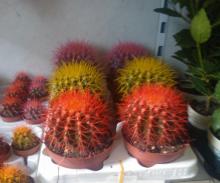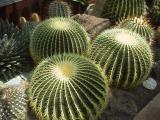I love you, Golden Barrel Cactus! If you haven’t got one own yet, you simply do not know what you are actually missing. As for me and a few of my friends, we have medium...
-
Images of echinocactus plant and pictures
Click here to see all articles about Echinocactus
Echinocactus – a Guest from Mexico on your Window-sill. Main Tips on Growing and Caring
If you are fond of cactuses, you might have heard of echinocactus and even have one at home. You should know that this plant needs special care. We will give you useful tips on how to grow and how to care. The main thing is to follow these instructions and you will have a nice green friend on the window-sill.
What is an Echinocactus Plant?
The motherland of echinocactus is Mexico. Hot, high deserts and the feet of the cliffs and slopes are its favorite places there. Therefore, it is no wonder that it likes the sun above all and needs much light. It is of a spherical shape with numerous ribs and densely covered with spines. It is important to place the pot with this cactus in the room which is permanently ventilated.
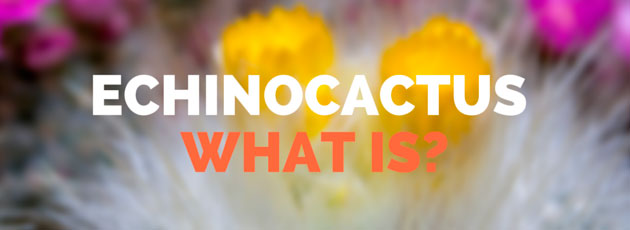
In summer you can keep the plant outdoors. People decorate balconies, verandas and terraces with funny yellow-barbed pellets. They look really nice especially when blooming with beautiful flowers.
The ancient Aztecs worshiped it as the god of rain. A seemingly strange idea: a dry plant, and suddenly, the rain god. However, the term is defined not by accident, because huge Mexican Echinocacti are real tanks with nutritious juice that is life-saving for desert dwellers.
There are 12 species of this succulent. The most wide-spread types of echinocactus are:
- echinocactus grusonii;
- echinocactus texensis;
- echinocactus polycephalus;
- echinocactus horizonthalonius;
You can choose the one you especially like and it will become a real decoration of your window. Some people are fond of breeding this type of cactuses and have a real kingdom of prickly balls at home. They grow slowly but become enormous. If you don’t know what to choose, look at the pictures of this plant and make an option.
You can also consult a specialist who works at a shop selling house plants. He will show you echinocactus images and real plants, and you will make the right choice. However, remember that buying a succulent you should create the conditions of its native place and learn how to care for it, so that it can blossom and grow.
Instructions on Echinocactus Care
It isn’t hard to take care of echinocactus. The plant isn’t fastidious or delicate. You shouldn’t learn a list of rules how to fertilize, water and prune it. Cacti are nice and easy to look after.
The most dangerous things for echinocactus plants are:
- Hypothermia of the ground clod.
- The lack of light.
- Waterlogging of the soil, especially in the winter season, which leads to rotting.
Echinocactus care doesn’t imply pruning as the plant has no leaves.
Every third watering is desirable to combine with the fertilizing.
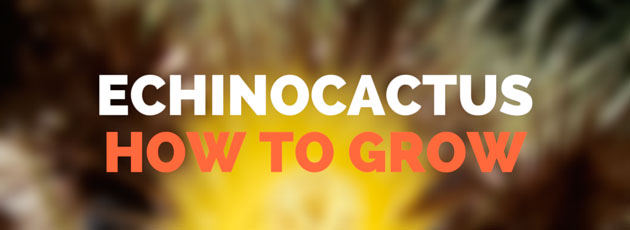
How to Grow Echinocactus
Temperature: Moderate. The succulent experiences the dormant phase in winter. So, the temperature should be +8-10 °C. The lowest possible can be + 5°C. Keep away from dampness. Cannot bear frosts. Dies immediately. From October to May should be kept indoors.
Air humidity: echinocactus is resistant to dry air, but regular spraying with warm water is very helpful.
Watering: moderate in spring and summer. Reduce it in fall. Remember that this plant can be watered only 2-3 times in winter. Caring for cacti remember of their natural conditions.
Feeding: From late spring to mid-summer. Add special fertilizer to the ground or water. You can buy them in stores selling goods for house plants. It is preferable to choose dressing that comes in a liquid form. However, don’t abuse. Too dense concentration might have a bad effect.
Combatting Diseases and Pests
The plant may suffer from attacks of the following pests and resulting from them diseases:
- Mealybug. It is of white color, covered with white hairs that grow on its body. If you spray the plant with water, this wrecker can hardly appear. But if it does, use special liquid insecticide to combat it.
- Spider mite. It is one of the most difficult to get rid of. At early stages you will see yellow lesions, and then they turn into brown spots. You can also see a web with moving reddish-brown dots - this is the spider mite. It may appear if the air in the room is too dry. A simple preventive measure is regular spraying with water. Most chemicals are ineffective to this wrecker.
- Quadraspidiotus perniciosus and coccidae. You can notice brown rounded scales on the plant that are hard to separate from the body. This is an adult stage of a dangerous pest of houseplants – Quadraspidiotus perniciosus. It is covered with a waxy shell that makes it invulnerable to chemical agents. The plants become sticky from their discharge, turn yellow and wither. The easiest way to destroy these sedentary animals is to catch them at the beginning of their appearance. Inspect the plant regularly. Use insecticides. Bear in mind that there are no specialized chemicals to combat beetles there, so choose an insecticide with the widest spectrum of activity.
If you water the succulent too much, there will begin root decay. This is the main disease that is met in echinocactus.
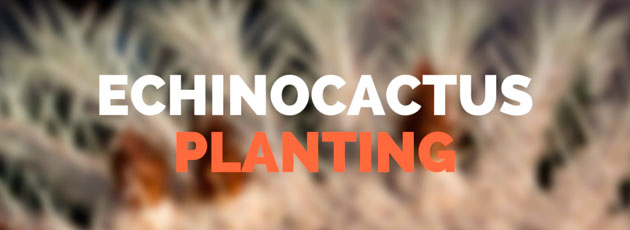
Major Rules of Planting
It is important to know how to plant an echinocactus in order not to damage little cactuses. Common soil isn’t good for it as your green friend will not get the necessary number of useful stuffs.
If you plan on planting and growing echinocactus, bear in mind the following instructions:
- Prepare the ground. It should consist of 2 parts of turf, 1 part of the leaf, 1 part of peat ground, 1 part of sand and some brick chips.
- Add lime or eggshells to make the soil rich in calcium.
- Transplanting should be done when you see that the succulent needs more space.
- Young cactuses are transplanted every 2-3 years, old – every 4-5 years.
- It is important to know when to transplant. It is not recommended to do it when it is cold. Do it on warm sunny days in any months from May to October.
What you Should Know about Echinocactus Cactus Seeds
Echinocacti propagation is performed by sowing seeds. They can be purchased at specialty stores. The soil should consist of sand and turf ground. Put a layer of drainage at the bottom of the bowls, then a layer of loose leaf soil and a layer of river sand. Don’t bury seeds much when sowing. Water well and cover with polyethylene. You will have little cacti within 2-3 months. Don’t water until there appear seedlings with two cotyledons. They will grow well in terms of proper lighting, ventilation, humidification and moderate temperature. Don’t touch them as it may have a bad influence on their growth.
This plant doesn’t require special measures of cultivation. The main thing about cacti is to know care instructions and follow them. This way you will avoid problems and see the first flower on your succulent. That’s a big joy and delight! That’s your prize!





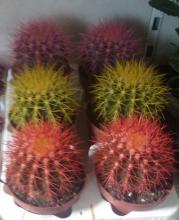 ,
, 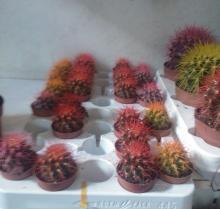 ,
, 